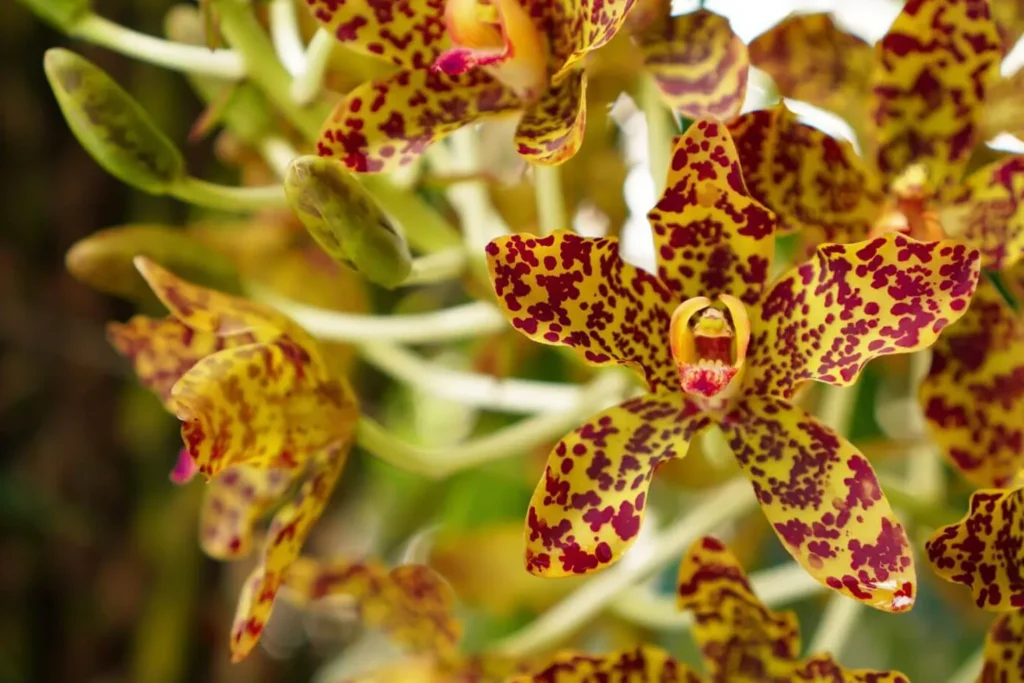
In Costa Rica, a rich variety of beautiful flowers can be found. Orchids sway gracefully in tropical gardens, while roses boast vibrant colors. Red ginger and heliconias captivate with their fiery and elongated blossoms.
The dry forests of Guanacaste burst with vivid hues from numerous tree species. Reserve areas showcase the delicate unfolding of Costa Rican coneflowers, and blue ginger mesmerizes with its electric blue shade. This floral paradise harmoniously attracts butterflies and moths, showcasing nature’s vibrant palette.
These flowers embody the resilience and creativity of nature, emphasizing the urgent need to protect Costa Rica’s extraordinary biodiversity. Costa Rica is home to a wide variety of beautiful flowers, including orchids, roses, red ginger, heliconias, Costa Rican coneflowers, and blue ginger. These flowers can be found in tropical gardens, dry forests, and reserve areas. They are a testament to the adaptation, resilience, and beauty of nature’s creativity.
Why is Costa Rica famous?
Costa Rica is renowned worldwide for its stunning natural landscapes, boasting breathtaking rainforests, pristine beaches, and majestic mountains.
- The country’s exceptional biodiversity, with over 500,000 wildlife species, many of which are rare or endangered, sets it apart.
- Additionally, Costa Rica is famous for its aromatic coffee, known for its exceptional quality and flavor. The country’s progressive government and dedication to sustainable practices have made it a global leader in environmental protection.
- Moreover, Costa Rica’s “Pura Vida” lifestyle, which emphasizes simplicity, happiness, and appreciation for life’s natural wonders, has captured the hearts of visitors from around the world.
- Lastly, the purple orchid known as “Guaria Morada” holds the distinction of being a national symbol, often regarded as a representation of the beauty embodied by Costa Rican women.
Costa Rica is known for its rich biodiversity, including a wide variety of beautiful and colorful flowers. Here are 20 stunning flowers that you can find in Costa Rica:
1. Orchid (Cattleya skinneri)
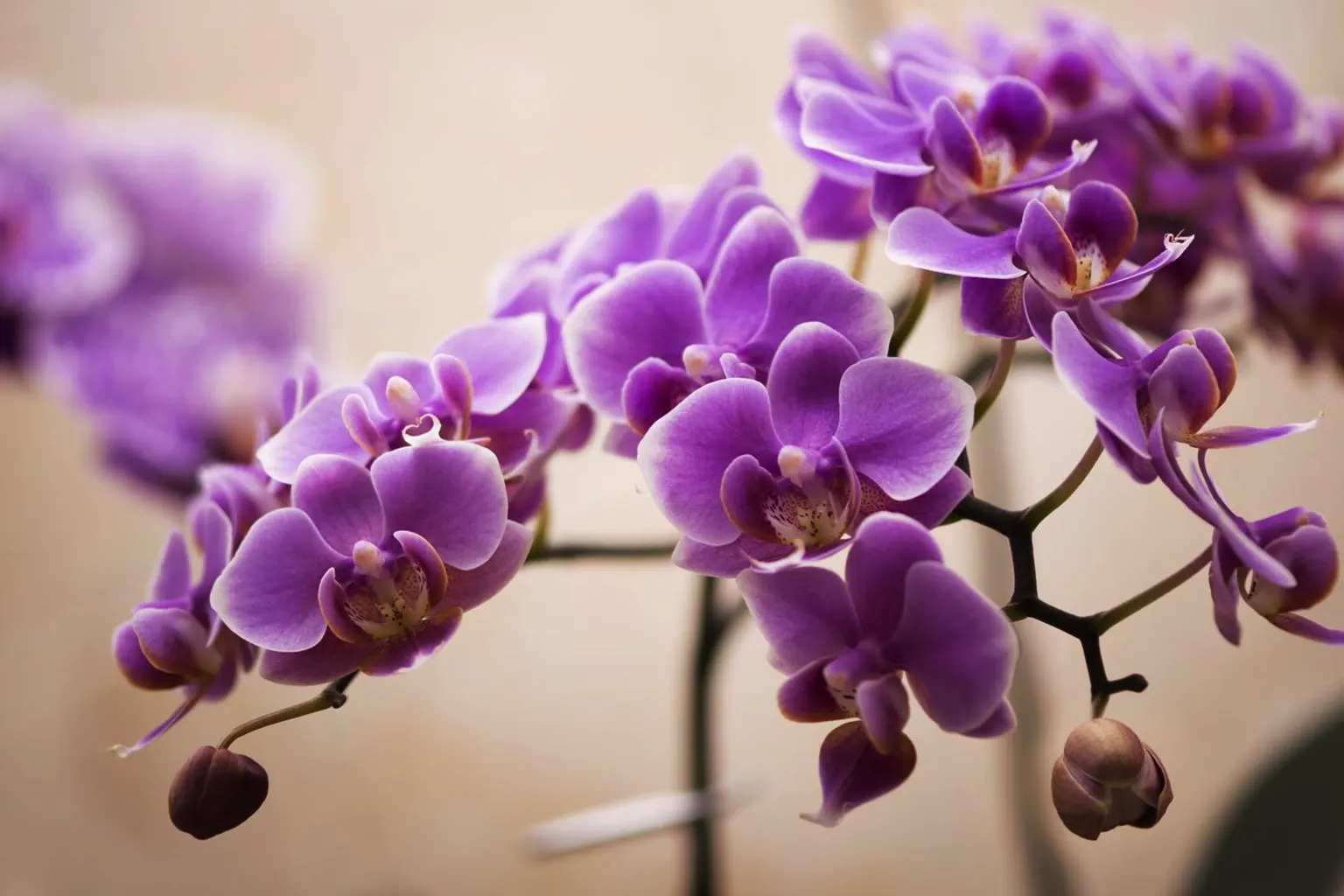
The scientific name is: Guarianthe skinneri
The higher classification is: Guarianthe
Rank: Species
Kingdom: Plantae
Highlights:
- Costa Rica’s National Flower is the Guaria Morada Orchid, scientifically known as Guarianthe skinneri or Cattleya skinneri. This stunning purple orchid is a national treasure, symbolizing the natural beauty found in Costa Rica.
- It is a native species that is found not only in Costa Rica but also across Central America. The Guaria Morada holds great significance to the people of Costa Rica, and its classification has evolved from Cattleya skinneri to Guarianthe skinneri.
As a member of the plant kingdom, this orchid exemplifies the extraordinary diversity and allure of Costa Rica’s floral realm.
2.Red Ginger (Alpinia purpurata)
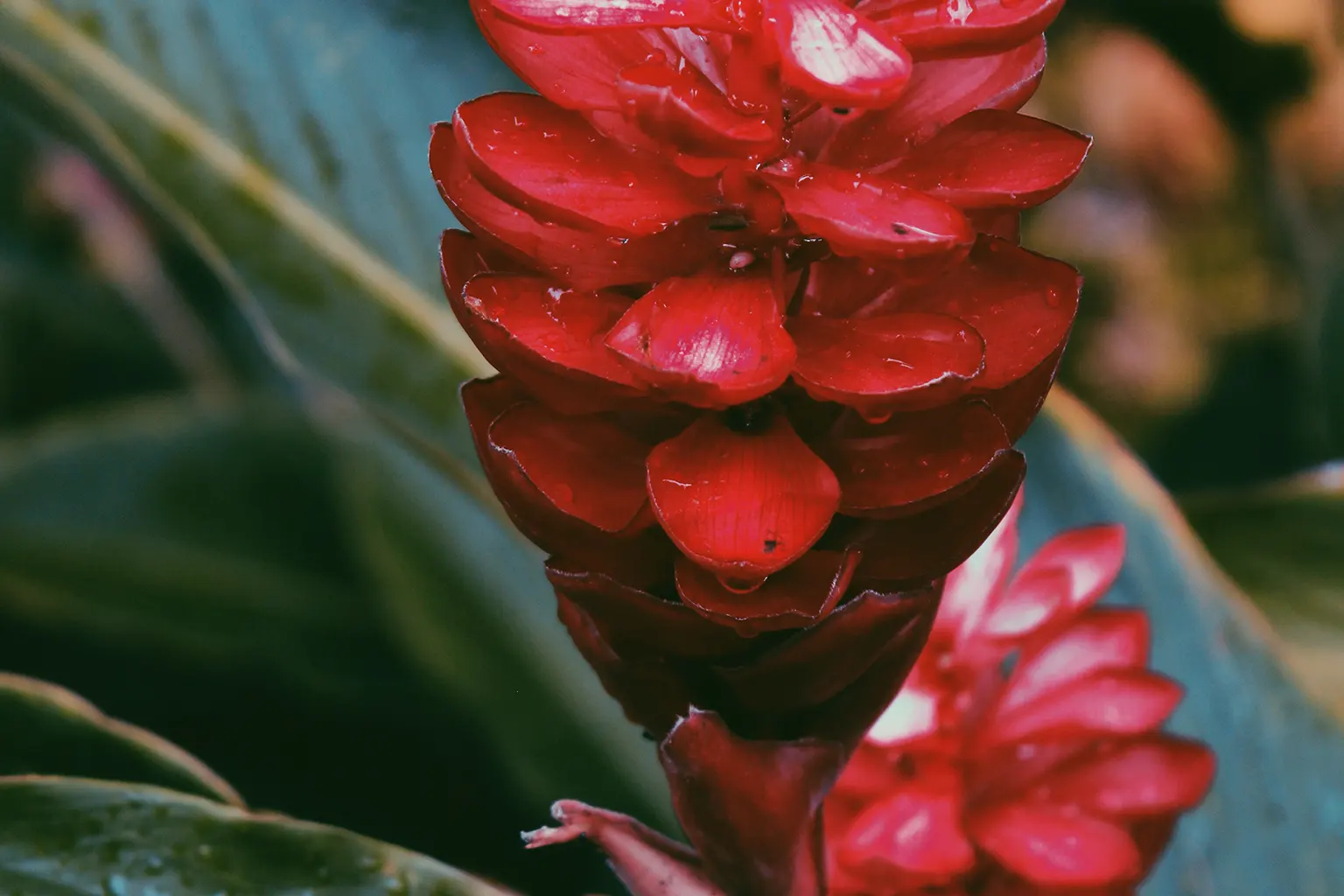
Scientific name: Alpinia purpurata
Higher classification: Alpinia
Rank: Species
Kingdom: Plantae
Highlights:
- One of the beautiful flowers found in Costa Rica is the Red Ginger (Alpinia purpurata). This vibrant and captivating plant showcases stunning red bracts that surround clusters of small, tubular flowers.
- The Red Ginger’s striking appearance adds a touch of tropical allure to the lush landscapes of Costa Rica. Its bold colors and graceful form make it a favorite choice for floral arrangements and landscaping.
Whether in gardens or natural settings, the Red Ginger stands as a testament to the remarkable beauty of Costa Rica’s flora.
3. Heliconia (Heliconia spp.)
Scientific name: Heliconia spp.
Higher classification: Heliconiaceae
Rank: Genus
Kingdom: Plantae
Highlights:
- One of the top beautiful flowers in Costa Rica is the Heliconia (Heliconia spp.), known for its vibrant and stunning inflorescence. The Heliconia Latispatha is the most common species, often found along roadsides and in sunny areas.
- With over 35 native species and various exotic hybrids, heliconias display a wide array of shapes and colors that create a captivating visual spectacle. These herbaceous plants, related to bananas, propagate easily through rhizomes.
- They serve as vital food sources and habitats for butterflies, spiders, ants, small frogs, insect larvae, and even tiny bats. Hummingbirds, co-evolving with heliconias, are their main pollinators, drawn to the bright red hues.
- Heliconias release nectar in small amounts from select flowers, encouraging hummingbirds to cross-pollinate multiple plants. Flowering primarily in the wet season, heliconias’ seeds are dispersed by birds that consume them.
The beauty and ecological importance of heliconias make them one of Costa Rica’s top beautiful flowers.
4.Bougainvillea (Bougainvillea spp.)
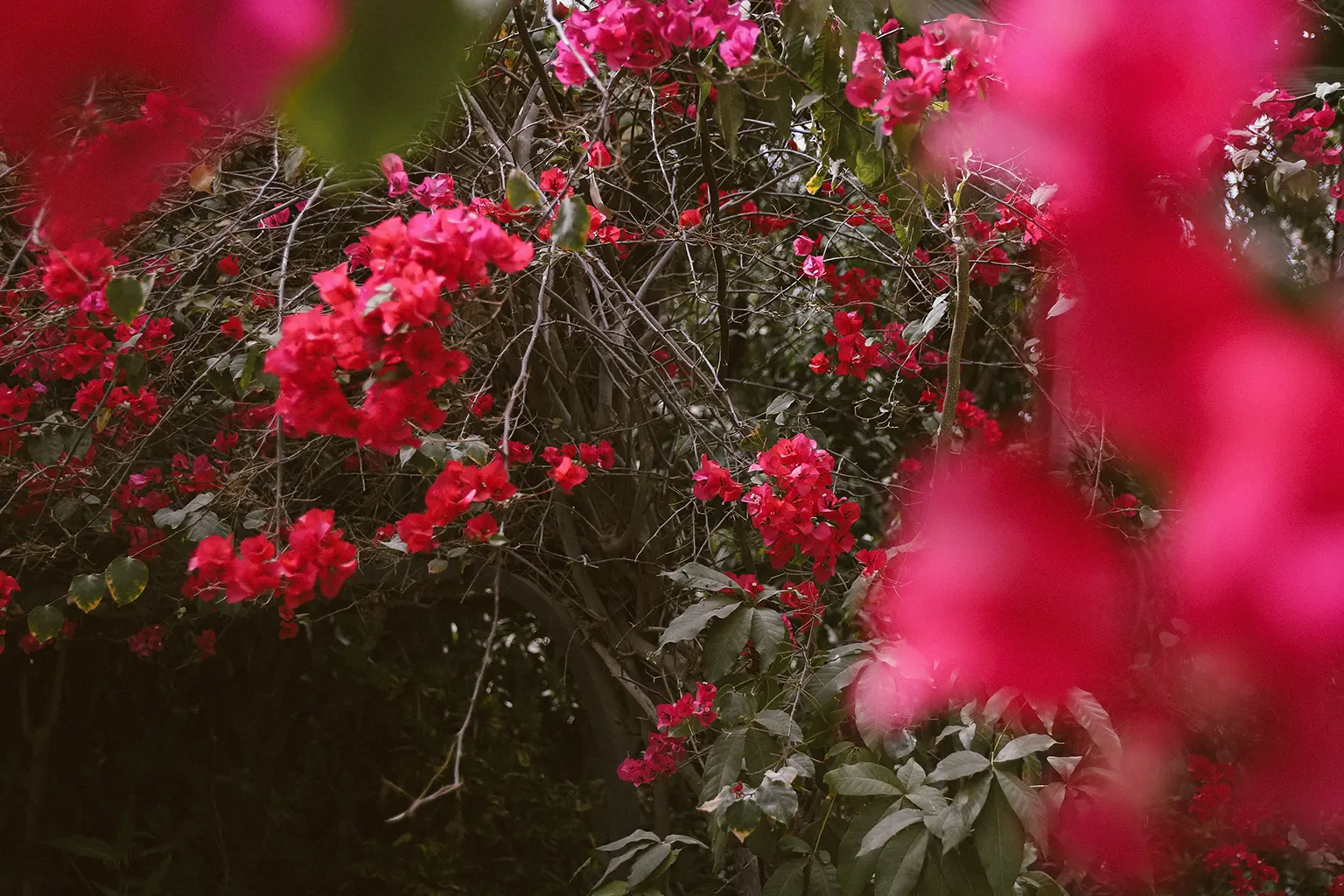
Scientific name: Bougainvillea spp.
Higher classification: Nyctaginaceae
Rank: Genus
Kingdom: Plantae
Highlights:
- Bougainvillea (Bougainvillea spp.) is a genus of vibrant and ornamental flowers found in Costa Rica. These flowers are known for their colorful bracts that surround their small, inconspicuous flowers.
- Bougainvillea comes in various shades as pink, purple, red, orange, and white, creating a burst of vibrant color. It is a popular choice for landscaping in Costa Rica and can be commonly seen in gardens, parks, fences, and buildings.
Bougainvillea’s hardy nature and ability to thrive in tropical climates make it one of the top beautiful flowers found in Costa Rica’s landscape.
5.Bird of Paradise (Strelitzia reginae)
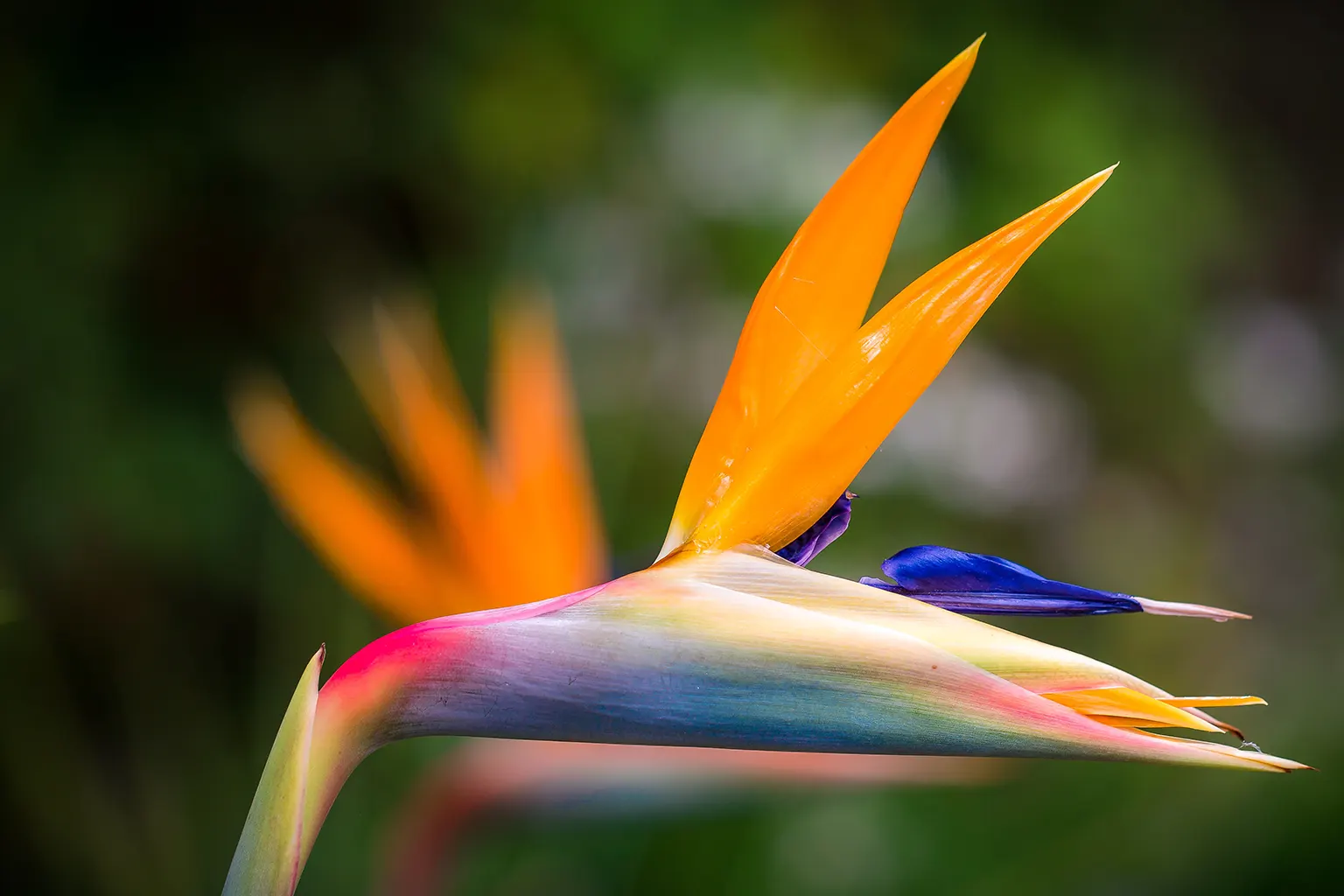
Scientific name: Strelitzia reginae
Higher classification: Strelitziaceae
Rank: Species
Kingdom: Plantae
Highlights:
- While the Bird of Paradise (Strelitzia reginae) is the flower of Costa Rica, it is still considered one of the top beautiful flowers in the world. Indigenous to South Africa, this stunning plant is highly sought after for its dramatic and ornamental flowers.
- With its vibrant and distinctive blooms resembling the head and beak of an exotic bird, the Bird of Paradise adds a touch of elegance and tropical charm to gardens and landscapes.
Although it is from Costa Rica, its striking appearance and popularity as an ornamental plant make it a favorite choice for flower enthusiasts around the globe.
6.Plumeria (Plumeria spp.)
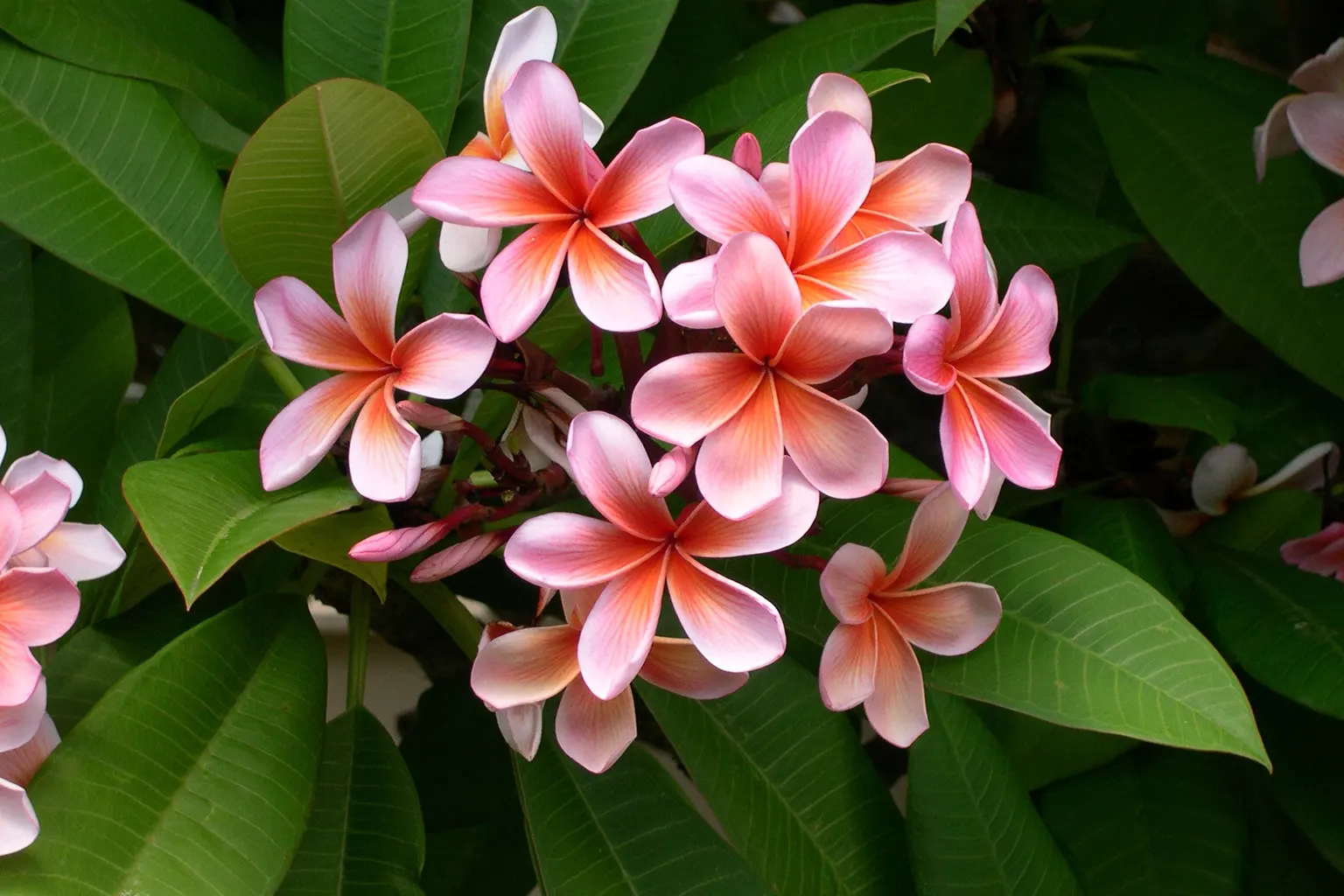
Family: Apocynaceae
Kingdom: Plantae
Genus: Plumeria; L.
Order: Gentianales
Highlights:
- Plumeria is a genus of beautiful Costa Rica flowers that are closely related to milkweeds and oleanders.
- Plumeria rubra is a deciduous tree that grows to 23-26 feet tall and is flushed with fragrant flowers of shades of pink, white, and yellow.
- Plumeria is a popular garden and park plant that is also used in temples and cemeteries.
- Despite its common name, plumeria is not a “true jasmine” and is not of the genus Jasminum.
7.Guaria Morada (Guarianthe skinneri)
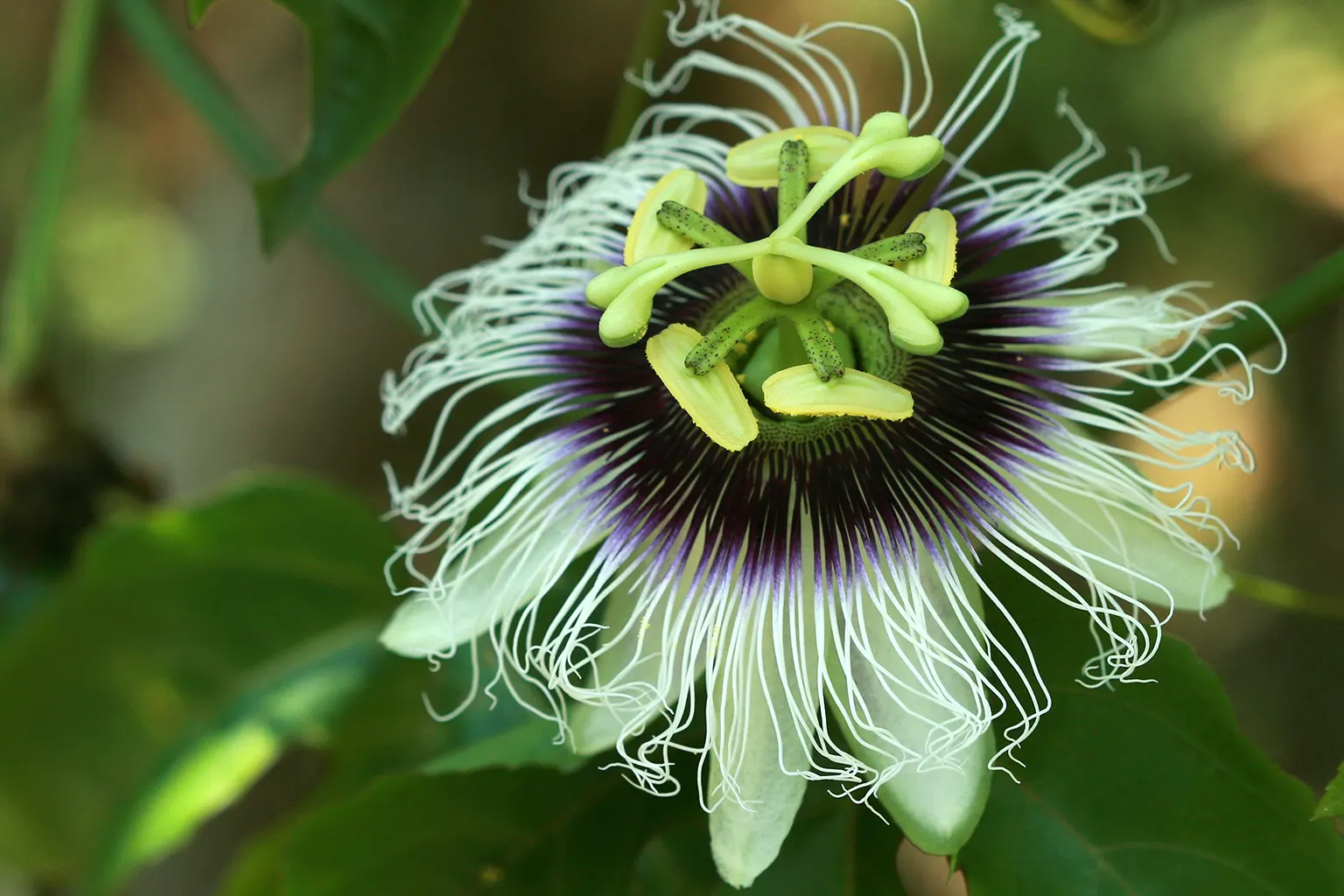
Scientific name: Guarianthe skinneri
Higher classification: Guarianthe
Rank: Species
Kingdom: Plantae
Highlights:
- Guaria Morada is a beautiful Costa Rica flower that is the national flower of the country.
- It is a type of orchid that is native to Central America and is known for its purple flowers.
Guaria morada blooms from January to April and is often used in Costa Rican culture, such as religious ceremonies and folk songs.
8. Angel's Trumpet (Brugmansia spp.)
Scientific name: Brugmansia
Order: Nightshade
Highlights:
- Angel’s trumpets are beautiful Costa Rica flowers that are not native to the country.
- They are large, fragrant flowers that are related to deadly nightshade.
- Angel’s trumpets are toxic and should not be ingested.
They are popular ornamental plants and can be found in gardens and parks.
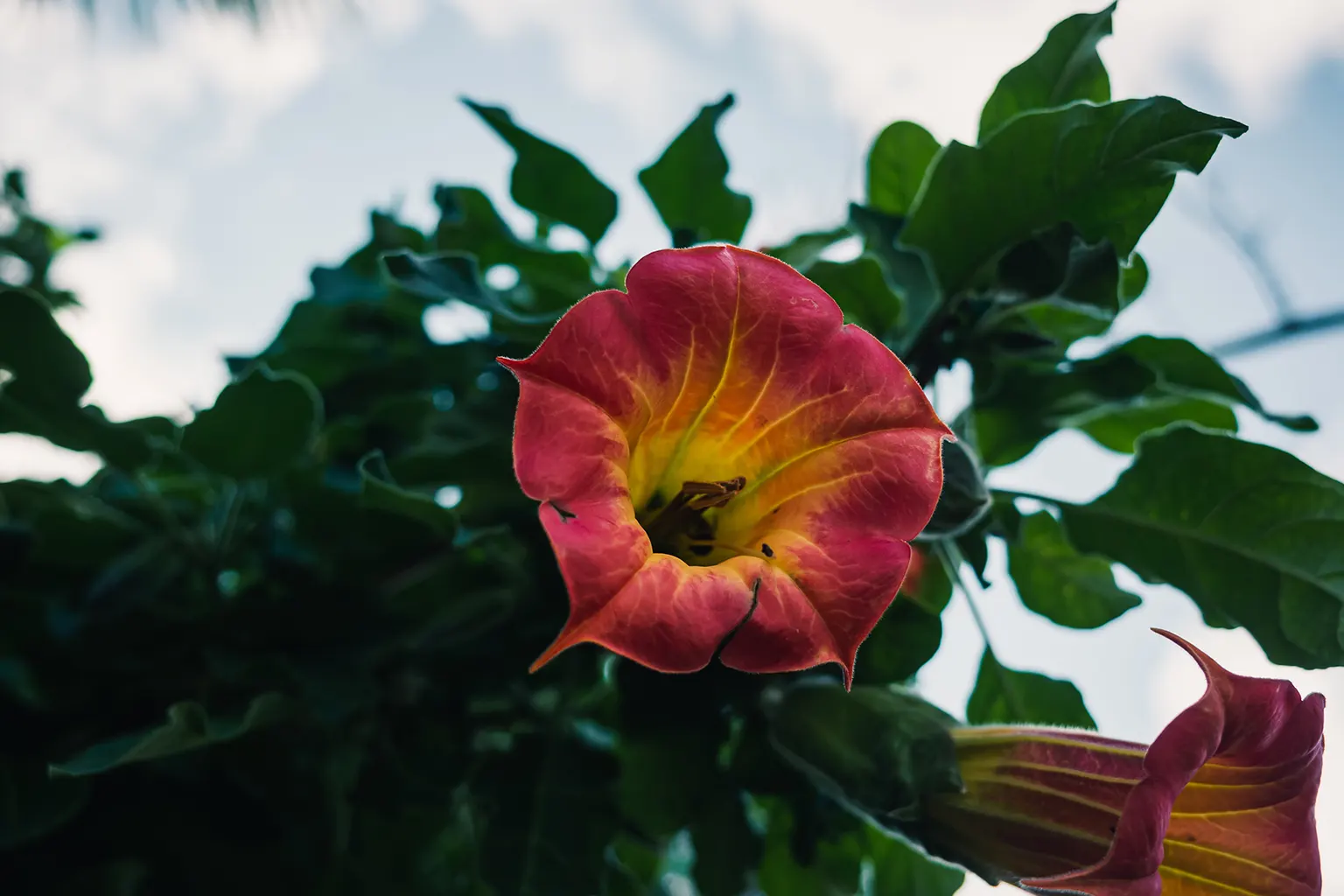
9.Scarlet Macaw (Caesalpinia pulcherrima)

Family: Fabaceae
Kingdom: Plantae
Species: C. pulcherrima
Order: Fabales
Highlights:
- The scarlet macaw (Caesalpinia pulcherrima) is a beautiful Costa Rica flower that is native to the tropics and subtropics of the Americas. It is a member of the pea family Fabaceae known for its bright red flowers.
- The flowers in Costa Rica are trumpet-shaped and have a diameter of up to 4 inches. Scarlet macaws bloom from spring to fall and are popular in Costa Rican gardens and parks.
- The flowers are also edible and used to make tea or syrup. Scarlet macaws are a symbol of beauty and abundance in Costa Rica and are often used in religious ceremonies and folk art.
- The scientific name, Caesalpinia pulcherrima, comes from the Latin words “caesalpinus”, meaning “chestnut-colored”, and “pulcherrima”, meaning “most beautiful”.
- The flowers are pollinated by hummingbirds and butterflies. The plant is commonly referred to as “Barbados Red,” “Pride of Barbados,” and “Flower of the Holy Ghost.”
- Scarlet macaws are a popular ornamental plant and can be found in gardens around the world.
However, the plant is also considered invasive in some areas, such as Hawaii.
10.Costa Rican Purple Sage (Salvia purpurea)
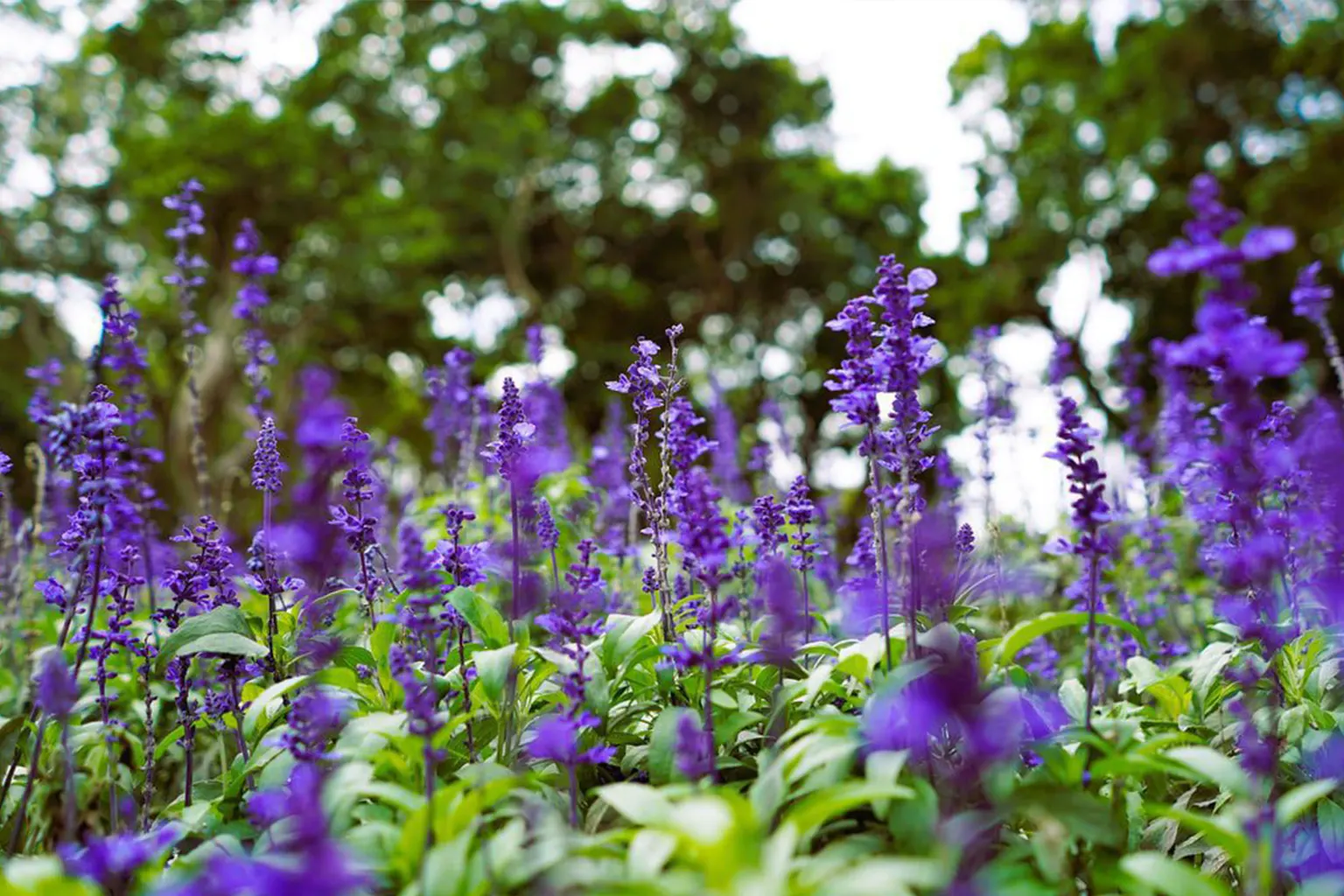
Family: Lamiaceae
Kingdom: Plantae
Species: Salvia guaranitica ‘Costa Rica’
Highlights:
- Salvia guaranitica ‘Costa Rica’ is a captivating plant from the mint family (Lamiaceae) that boasts stunning blue flowers and lush green foliage. It grows upright, reaching heights of 3-4 feet (90-120 cm), and its leaves are arranged oppositely along the stems.
- This variety attracts pollinators like butterflies and hummingbirds and can thrive in various climates. With minimal maintenance requirements, it is an excellent choice for borders, perennial beds, and containers, adding elegance to any outdoor space.
- Salvia guaranitica ‘Costa Rica’ pays homage to its historical use by the Guaraní people while providing ornamental beauty.
11. Yellow Bell (Tecoma stans)
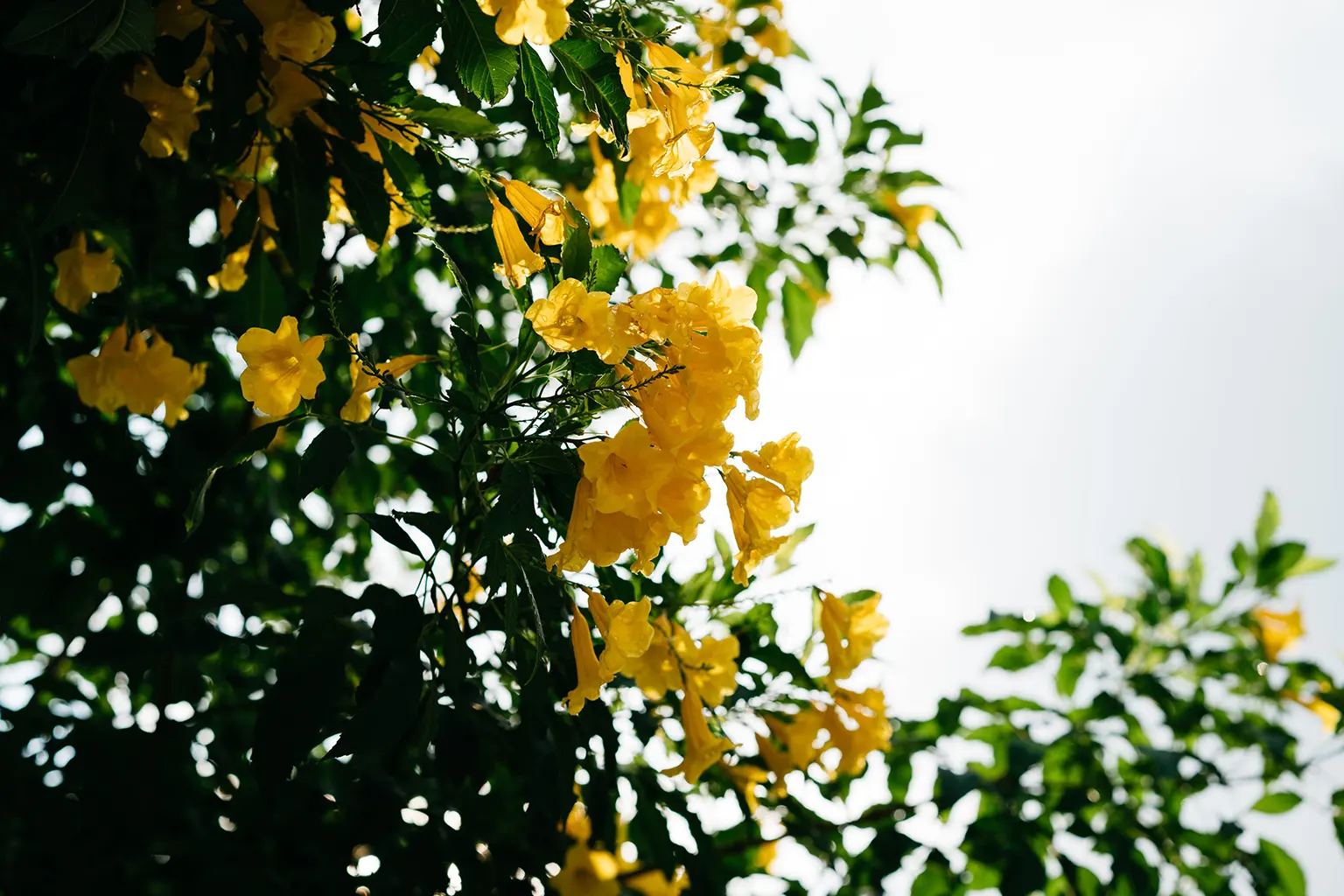
Scientific name: Tecoma stans
Family: Bignoniaceae
Order: Lamiales
Kingdom: Plantae
Highlights:
- Yellow bell (Tecoma stans) is a beautiful flower native to the Americas and commonly found in Costa Rica. It belongs to the Bignoniaceae family and is known for its stunning bright yellow, trumpet-shaped flowers.
- These 2-inch diameter flowers bloom from spring to fall, making them a popular sight in Costa Rican gardens and parks. Yellow bells are drought-tolerant and can thrive in full sun or partial shade, making them an excellent choice for landscaping.
- They are pollinated by hummingbirds and butterflies and are also known by other names such as “yellow trumpetbush,” “yellow elder,” and “ginger Thomas.”
While beloved as an ornamental plant, it is important to note that yellow bell can be invasive in certain regions like Hawaii.
12.Costa Rican Marigold (Tagetes erecta)
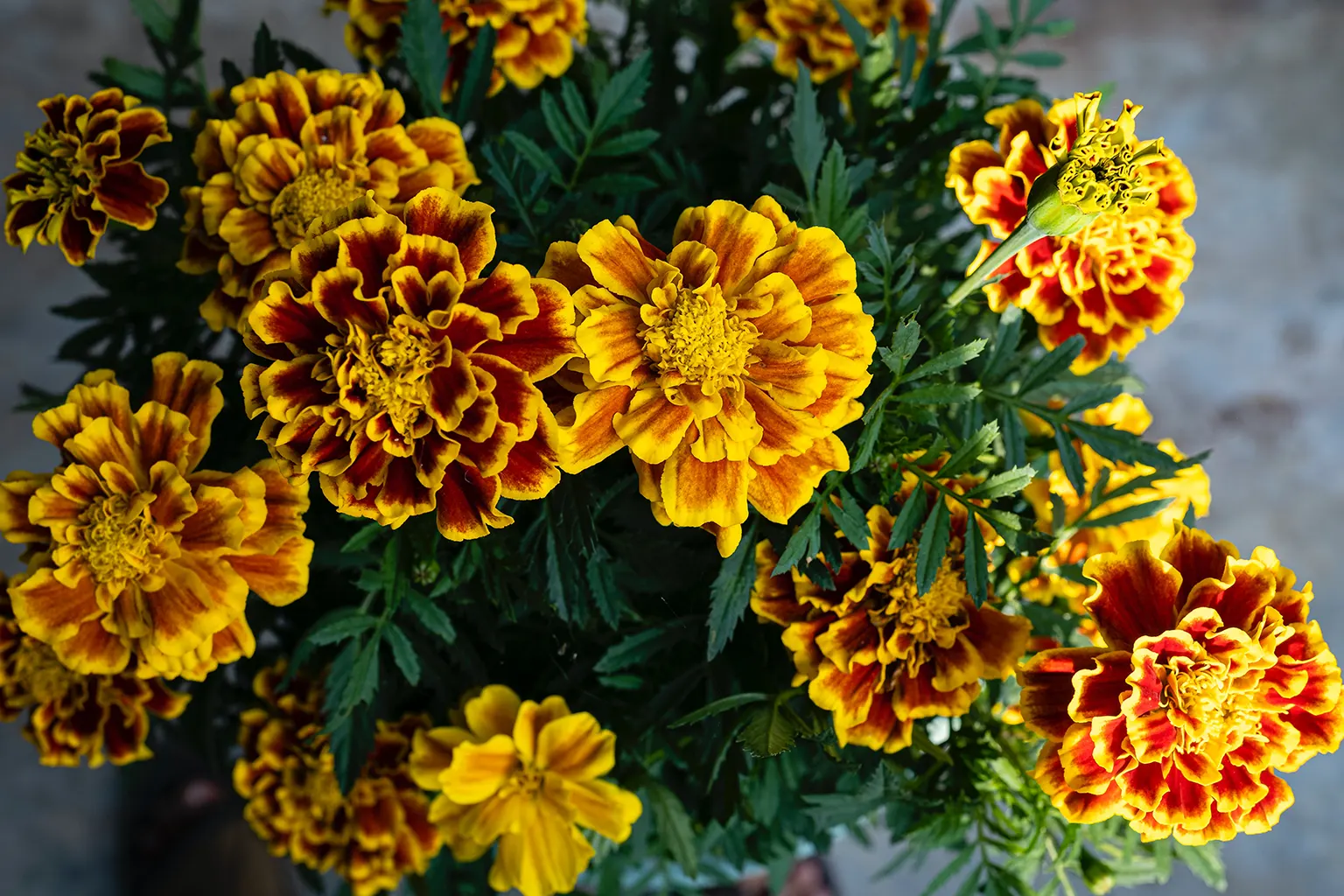
Scientific name: Tagetes erecta.
Family: Asteraceae
Kingdom: Plantae.
Highlights:
- Costa Rican marigold (Tagetes erecta) is a stunning flower native to Mexico and Central America, including Costa Rica. This member of the Asteraceae family, commonly known as the daisy family, displays vibrant orange and yellow flowers.
- With a diameter of around 2 inches, these flowers bloom from spring to fall, adding beauty to Costa Rican gardens and parks. Costa Rican marigolds are well-suited for landscaping due to their ability to tolerate drought and grow in both full sun and partial shade.
- The scientific name, Tagetes erecta, refers to its upright growth habit. Bees and butterflies are attracted to these flowers for pollination. The plant is additionally recognized by the names “American marigold,” “African marigold,” and “big marigold.”
While Costa Rican marigolds are popular worldwide as ornamental plants, caution is needed as they can be invasive in certain regions like Hawaii.
13. Jade Vine (Strongylodon macrobotrys)

Scientific name: Strongylodon macrobotrys
Higher classification: Strongylodon
Family: Fabaceae
Kingdom: Plantae
Highlights:
- Jade Vine (Strongylodon macrobotrys) is a beautiful Costa Rican flower known for its vibrant turquoise-colored blooms.
- It is a tropical vine that belongs to the legume family, Fabaceae. The unique and stunning flowers of the Jade Vine make it a prized sight in Costa Rican gardens and landscapes.
14.Torch Ginger (Etlingera elatior)
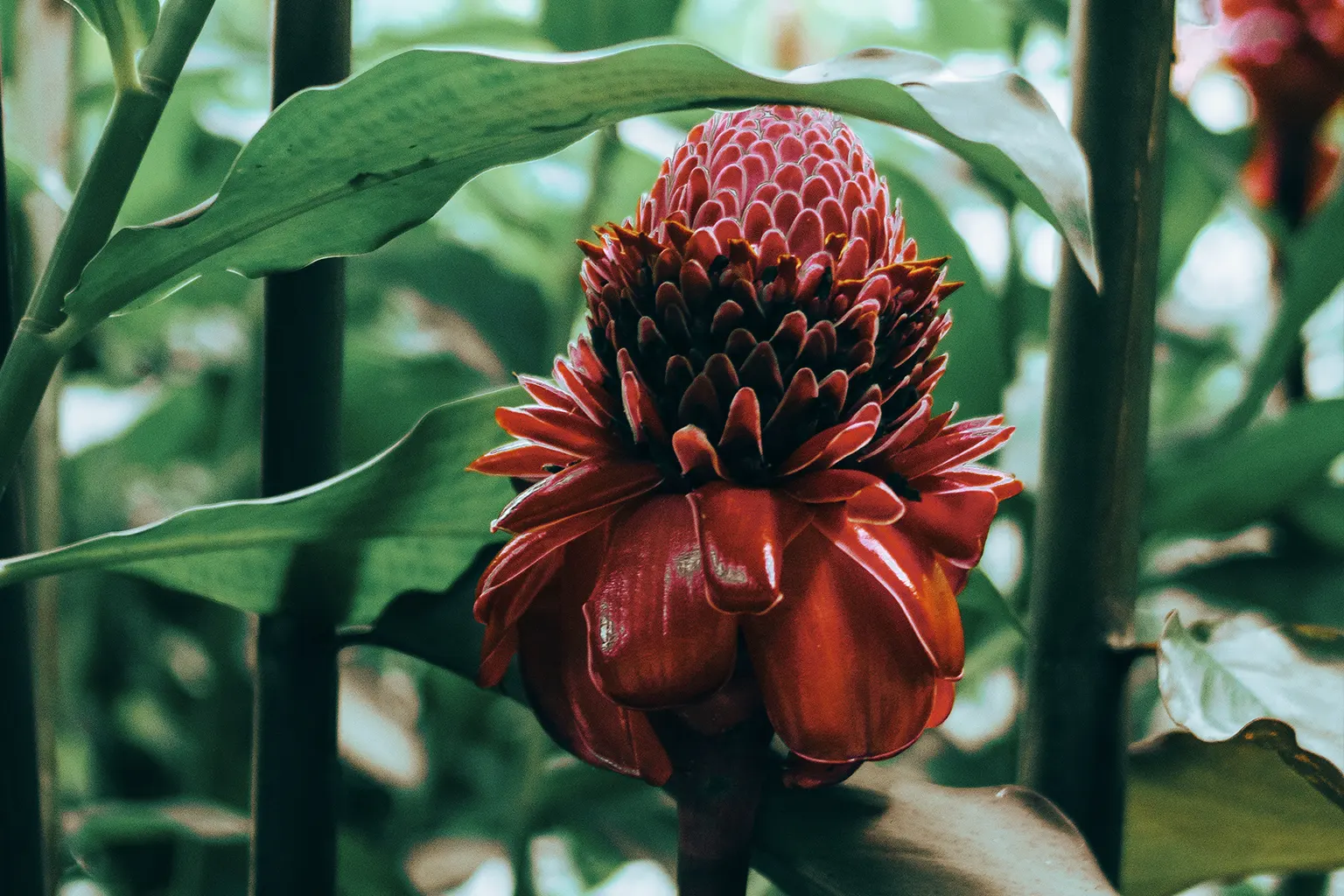
Scientific name: Etlingera elatior
Family: Zingiberaceae
Kingdom: Plantae
Order: Zingiberales
Highlights:
- Torch Ginger, also known as Etlingera elatior, is a captivating flower native to Southeast Asia, including Costa Rica. It belongs to the Zingiberaceae family, which includes ginger and turmeric plants.
- Torch Ginger is renowned for its tall, impressive inflorescence with vibrant, cone-shaped flowers that range in color from pink to red.
- These showy blooms are often used in floral arrangements and are highly valued for their ornamental appeal. Torch Ginger thrives in tropical climates and can be found in gardens and landscapes, adding a touch of exotic beauty.
15. Passionflower (Passiflora spp.)
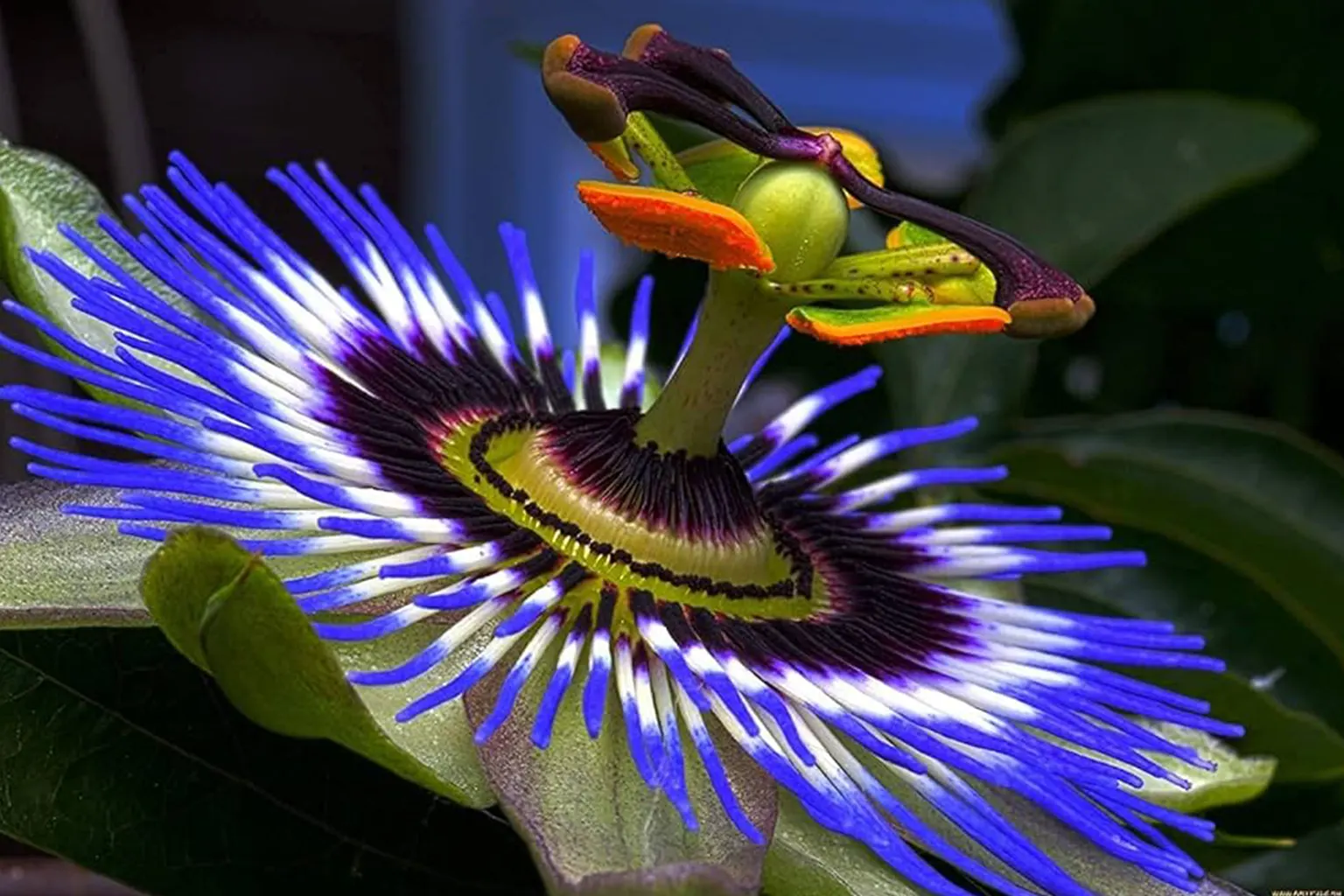
Scientific name: Passiflora spp.
Family: Passifloraceae
Kingdom: Plantae
Order: Malpighiales
Highlights:
- Passionflowers, scientifically known as Passiflora spp., are captivating plants found in various species. They belong to the Passifloraceae family and the Plantae kingdom. Passionflowers are notable for their intricate and exotic flowers, often displaying vibrant colors and unique structures.
- In addition to their ornamental value, passionflowers hold cultural significance and are used in traditional medicine in certain regions, including Costa Rica.
- The diverse range of passionflower species offers edible flowers that can be enjoyed as a tea or used for making flavorful juices. These remarkable features and cultural uses make passion flowers a noteworthy botanical treasure.
16.Ti plant
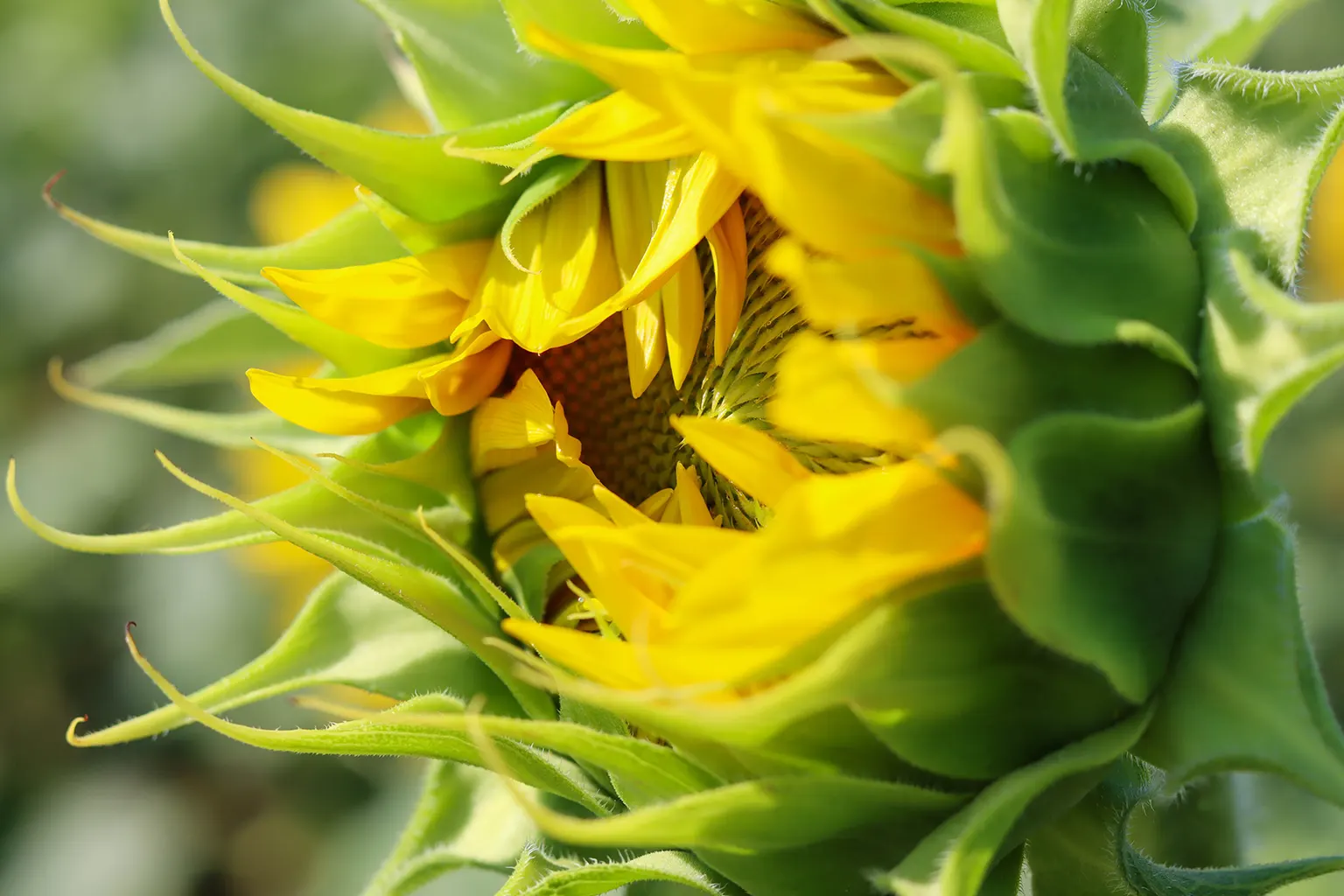
Scientific name: Cordyline fruticosa
Family: Asparagaceae
Kingdom: Plantae
Order: Asparagales
Highlights:
- The Ti plant, scientifically known as Cordyline fruticose, belongs to the Asparagaceae family and the Plantae kingdom. With its vibrant and broad leaves in various colors, it is highly valued for its ornamental appeal in gardens and landscapes.
- The Ti plant holds cultural significance in Polynesian and Hawaiian traditions, representing luck and protection. Some varieties of the Ti plant are used in traditional medicine.
- Its striking appearance and cultural importance make it a popular choice for both its beauty and symbolic meaning.
17.Costa Rican Coneflower (Montanoa grandiflora)
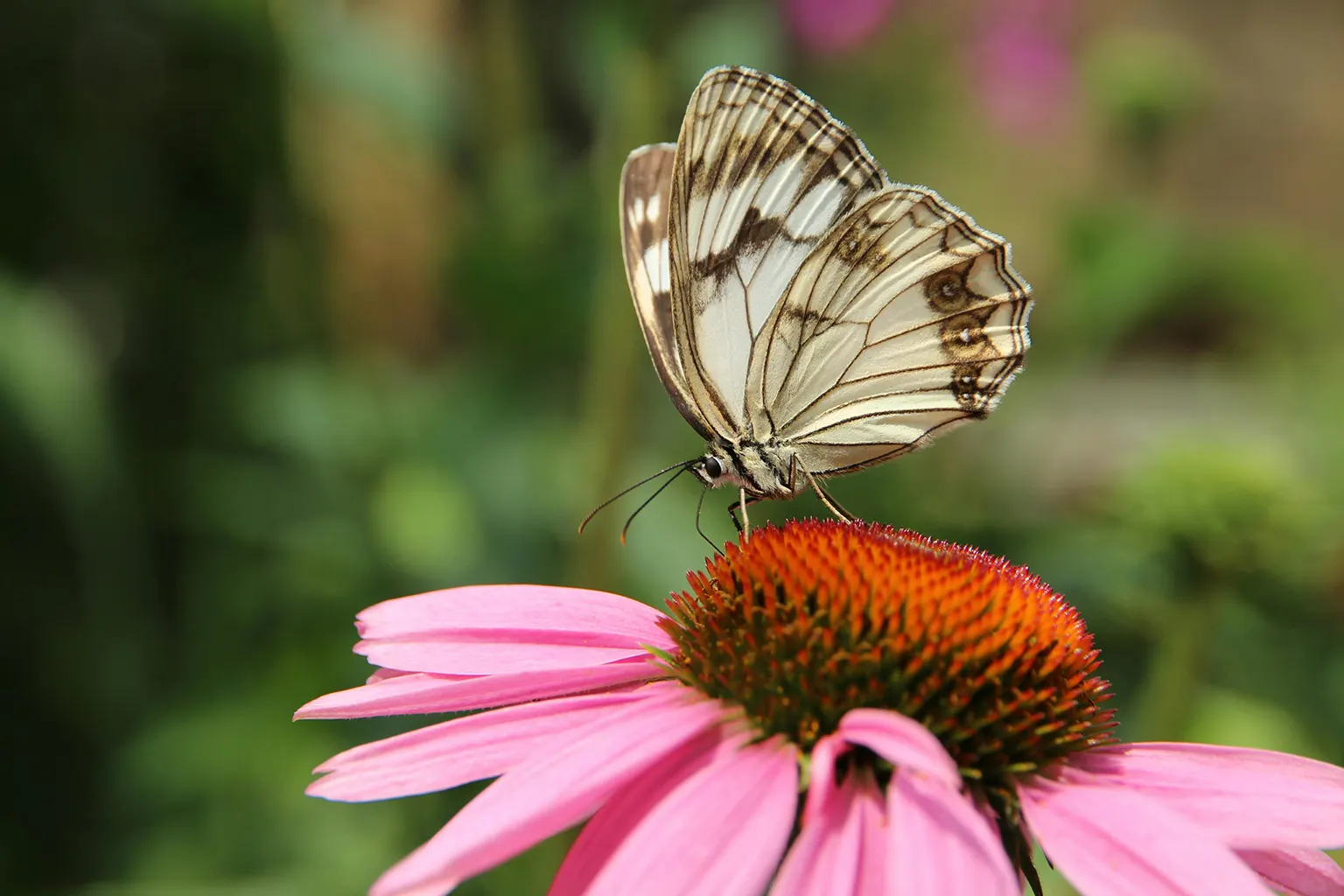
Scientific name: Montanoa grandiflora
Family: Asteraceae
Kingdom: Plantae
Order: Asterales
Highlights:
- The Costa Rican Coneflower, scientifically known as Montanoa grandiflora, is a notable flower found in Costa Rica. It belongs to the Asteraceae family and the Plantae kingdom.
- The Costa Rican Coneflower stands out for its striking appearance and large, showy flowers.
- It is a captivating addition to gardens and landscapes, attracting attention with its abundant white blooms. As a member of the Asterales order, it shares its classification with other well-known flower families.
- The Costa Rican Coneflower adds beauty and elegance to its surroundings, making it a favorite choice for floral displays and ornamental purposes.
18. Blue Ginger (Dichorisandra thyrsiflora)
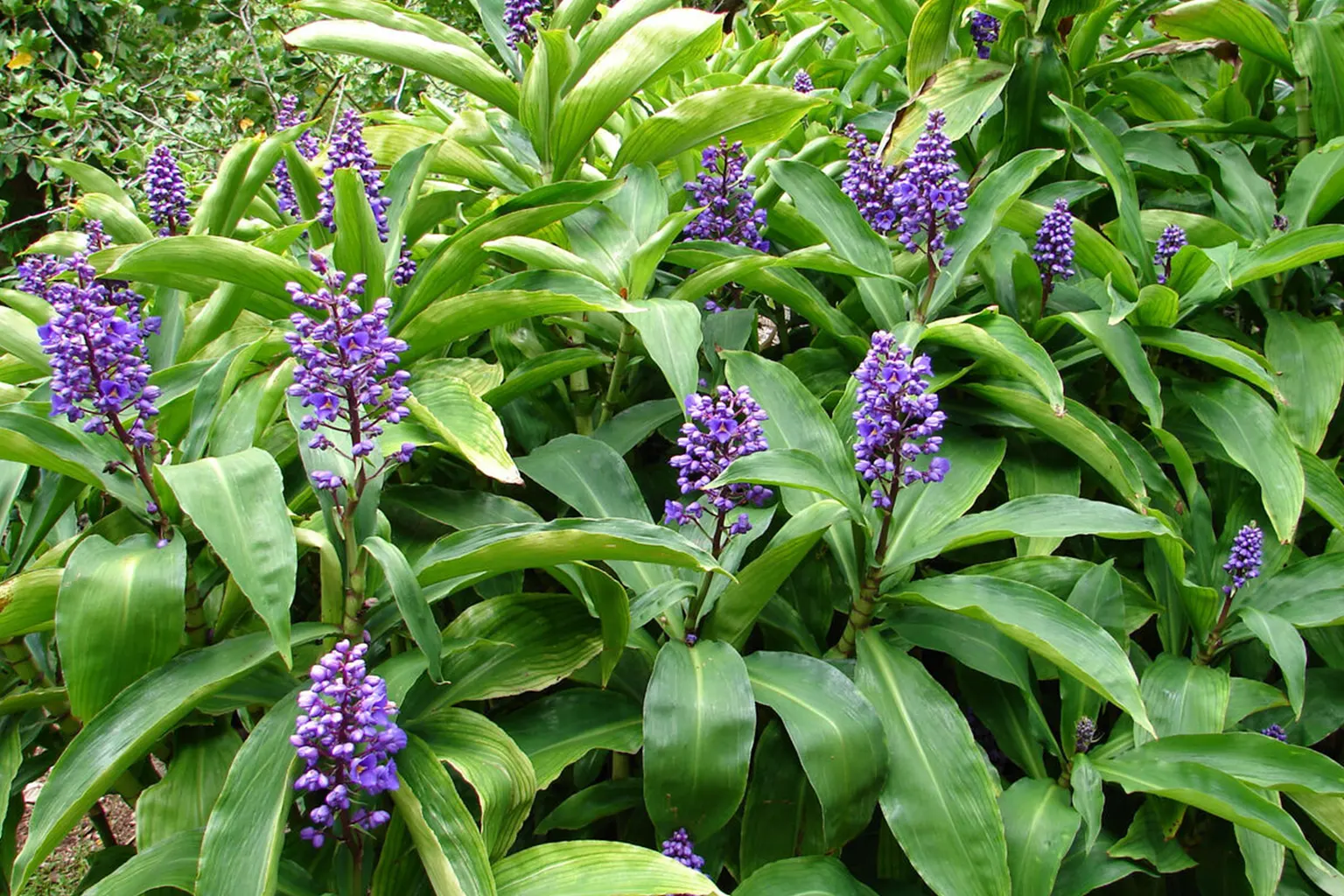
Scientific name: Dichorisandra thyrsiflora
Family: Commelinaceae
Kingdom: Plantae
Order: Commelinales
Highlights:
- Blue Ginger, scientifically known as Dichorisandra thyrsiflora, is a captivating plant found in various regions. It belongs to the Commelinaceae family and the Plantae kingdom. Blue Ginger stands out for its stunning blue-purple flowers and vibrant foliage.
- It is an eye-catching addition to gardens and landscapes, adding a touch of exotic beauty. As a member of the Commelinales order, it shares its classification with other unique and diverse plant species.
- Blue Ginger’s striking appearance and remarkable colors make it a popular choice for ornamental purposes, captivating the attention of onlookers.
19.Wild Vanilla Orchid (Vanilla pompona)
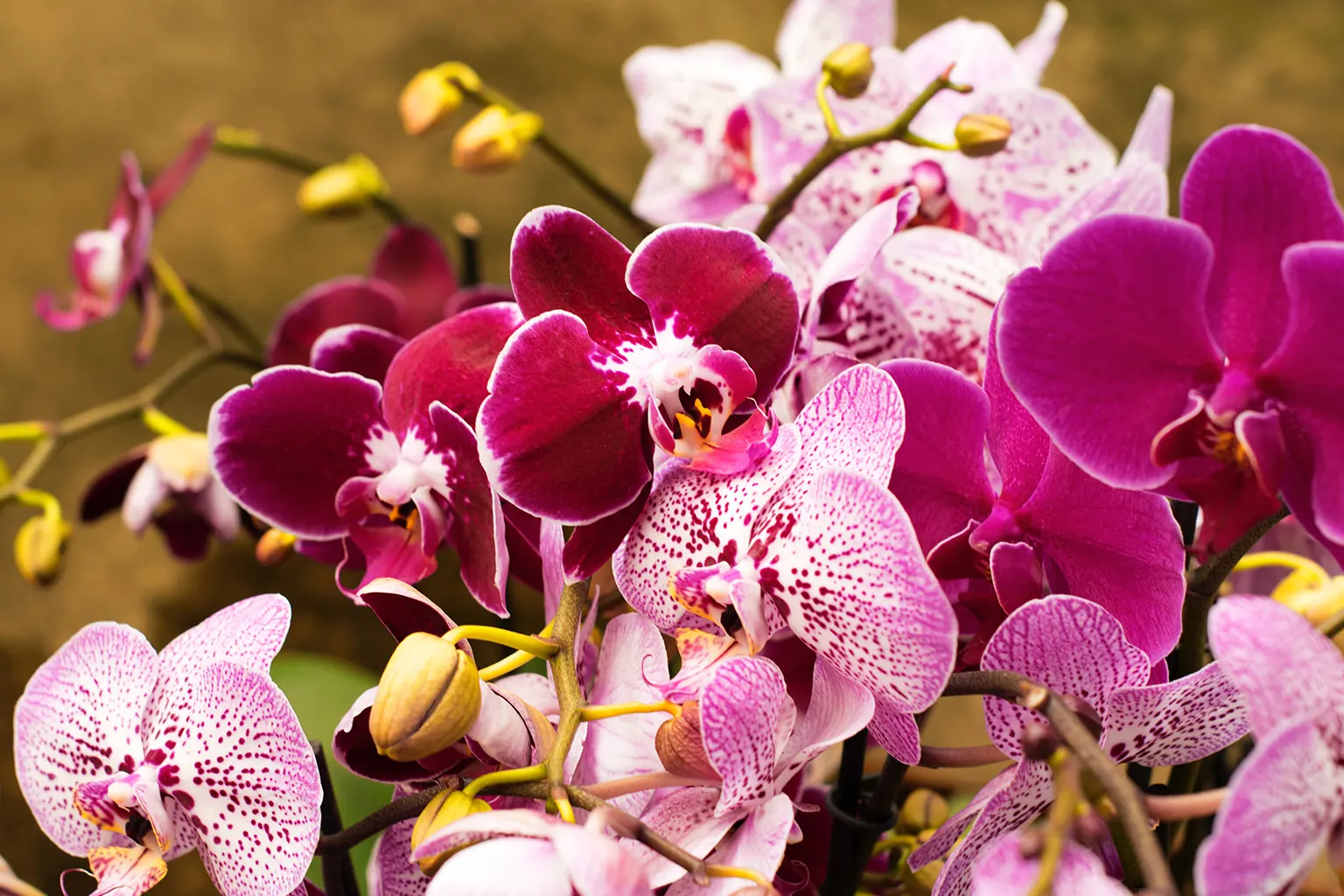
Scientific name: Vanilla pompona
Family: Orchidaceae
Kingdom: Plantae
Order: Asparagales
Highlights:
- The Wild Vanilla Orchid, scientifically known as Vanilla pompona, is a fascinating orchid species. It belongs to the Orchidaceae family and the Plantae kingdom.
- The Wild Vanilla Orchid is notable for its delicate and fragrant flowers, which have a creamy white color and a unique shape. This orchid species is native to tropical regions, including Costa Rica.
- It is especially prized for its seeds, which are used in the production of vanilla flavoring. The Wild Vanilla Orchid is a beautiful and aromatic plant, adding a touch of elegance to its natural habitat and capturing the interest of orchid enthusiasts.
20.Scarlet Sage (Salvia coccinea)
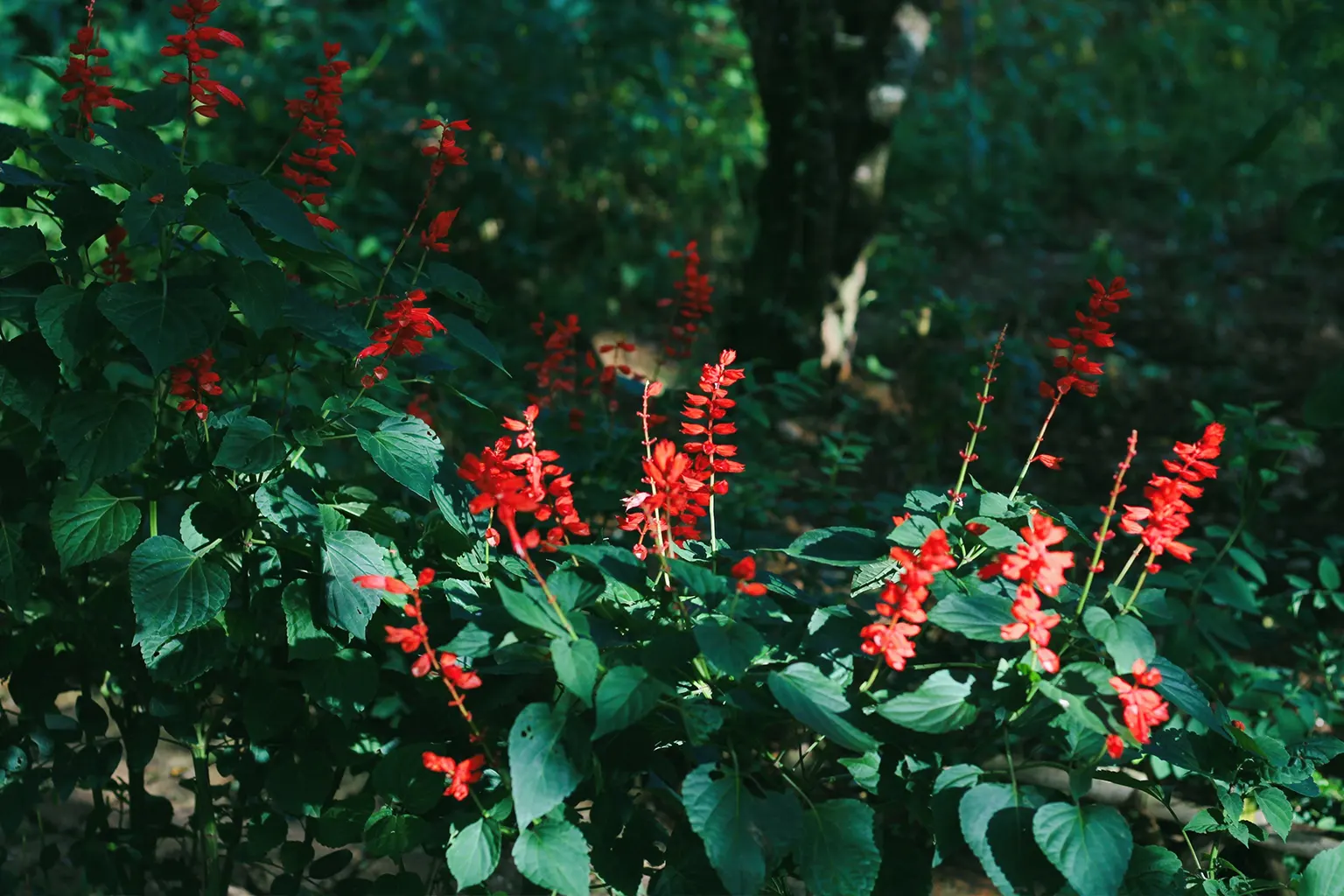
Scientific name: Salvia coccinea
Family: Lamiaceae
Kingdom: Plantae
Order: Lamiales
Highlights:
- The Scarlet Sage, scientifically known as Salvia coccinea, is a vibrant flowering plant. It belongs to the Lamiaceae family and the Plantae kingdom.
- The Scarlet Sage stands out for its striking red flowers, which add a burst of color to gardens and landscapes. As a member of the Lamiales order, it shares its classification with other well-known plant families.
- The Scarlet Sage is cherished for its ornamental value, attracting pollinators like butterflies and hummingbirds. Its bold and eye-catching blooms make it a favorite choice for adding visual appeal to outdoor spaces.
These are just a few examples of the beautiful flowers that can be found in Costa Rica. The country’s tropical climate and diverse ecosystems provide an ideal environment for a wide range of floral species to thrive.
FAQs
What is the common name for guarianthe skinneri?
The common names for Guarianthe skinneri are Skinner’s Guarianthe, The Easter Orchid, Guaria Morada, Candelaria, and Flor de San Sebastian. These names are used to refer to this particular species of orchid found in Costa Rica.
What flower is Costa Rica known for?
The national flower of Costa Rica, known as the Guaria Morada, holds the endearing nickname of the “purple country girl.” This exquisite orchid boasts a captivating display of purple tones and delicate, rounded petals. Embedded within Tico culture, this flower is believed to bring good luck and fortune.










1 thought on “Top 20 Beautiful Costa Rica Flowers”